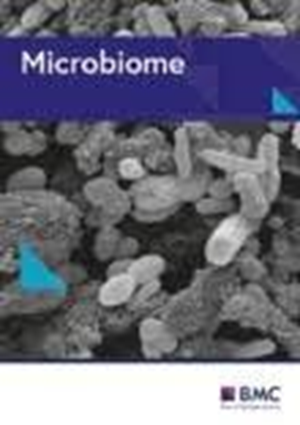恒温与梯度加热厌氧消化过程中产生更多氢气的微生物机制
IF 13.8
1区 生物学
Q1 MICROBIOLOGY
引用次数: 0
摘要
利用丰富的木质纤维素生产清洁能源氢气(H2)是化石能源的替代品。恒温(35、55 和 65 °C)和梯度加热温度(35 至 65 °C)对通过高固体厌氧消化(HS-AD)从富含木质纤维素的秸秆中产生氢气的调节潜力缺乏比较,这是一个重要的影响因素。更重要的是,需要研究温度调节 H2 积累的微生物机制。恒定 65 °C,木质素残留量最低(1.93%),纤维素和半纤维素释放量最大,H2 产量最高(26.01 mL/g VS)。而在 35 和 55 °C 下,H2 产量分别只有 14.56 和 24.13 mL/g VS。为了进一步探索超高温(65 °C)的潜力,采用梯度加热条件(35 至 65 °C)进行了 HS-AD。然而,与恒温 65 °C 相比,梯度加热条件下的木质素残留量(2.49%)更高,H2 产量(13.53 mL/g VS)也低于梯度加热条件下(47.98%)。此外,元基因组分析表明,纤维素/半纤维素水解细菌和基因(主要是 Thermoclostridium,以及 xynA、xynB、abfA、bglB 和 xynD)、产 H2 细菌和相关基因(主要是 Thermoclostridium,以及 nifD、nifH 和 nifK)以及微生物运动和代谢功能在 65 °C 条件下得到了富集。然而,在梯度加热条件下,双组分系统的富集导致缺乏高度富集的超高温纤维素/半纤维素水解菌属和相关基因,而是富集了 H2 消耗菌属和基因(主要是 Acetivibrio、hyaB 和 hyaA),导致 H2 产生较弱。木质素降解过程并不直接决定 H2 的积累,它实际上是由促进 H2 生产/消耗的细菌/基因调控的。此外,是温度而不是木质素降解酶、细菌和基因促进了微生物的物质转移和新陈代谢,从而加强了木质素的水解过程。温度是 HS-AD 产生 H2 的关键参数之一,我们开发了一种重要的调控策略,丰富了温度调控产生 H2 的理论基础,进一步拓展了该领域的研究视野。本文章由计算机程序翻译,如有差异,请以英文原文为准。
Microbial mechanisms for higher hydrogen production in anaerobic digestion at constant temperature versus gradient heating
Clean energy hydrogen (H2) produced from abundant lignocellulose is an alternative to fossil energy. As an essential influencing factor, there is a lack of comparison between constant temperatures (35, 55 and 65 °C) and gradient heating temperature (35 to 65 °C) on the H2 production regulation potential from lignocellulose-rich straw via high-solid anaerobic digestion (HS-AD). More importantly, the microbial mechanism of temperature regulating H2 accumulation needs to be investigated. Constant 65 °C led to the lowest lignin residue (1.93%) and the maximum release of cellulose and hemicellulose, and the highest H2 production (26.01 mL/g VS). H2 production at 35 and 55 °C was only 14.56 and 24.13 mL/g VS, respectively. In order to further explore the potential of ultra-high temperature (65 °C), HS-AD was performed by gradient heating conditions (35 to 65 °C). However, compared to constant 65 °C, gradient heating conditions led to higher lignin residue (2.49%) and lower H2 production (13.53 mL/g VS) than gradient heating conditions (47.98%). In addition, metagenomic analysis showed the cellulose/hemicellulose hydrolyzing bacteria and genes (mainly Thermoclostridium, and xynA, xynB, abfA, bglB and xynD), H2-producing bacteria and related genes (mainly Thermoclostridium, and nifD, nifH and nifK), and microbial movement and metabolic functions were enriched at 65 °C. However, the enrichment of two-component systems under gradient heating conditions resulted in a lack of highly-enriched ultra-high-temperature cellulose/hemicellulose hydrolyzing genera and related genes but rather enriched H2 consumption genera and genes (mainly Acetivibrio, and hyaB and hyaA) resulting in a weaker H2 production. The lignin degradation process does not directly determine H2 accumulation, which was actually regulated by bacteria/genes contributing to H2 production/consumption. In addition, it is temperature that enhances the hydrolysis process of lignin rather than lignin-degrading enzymes, bacteria and genes by promoting microbial material transfer and metabolism. In terms of temperature, one of the key parameters of HS-AD for H2 production, we developed an important regulatory strategy, enriched the theoretical basis of temperature regulation for H2 production to further expanded the research horizon in this field.
求助全文
通过发布文献求助,成功后即可免费获取论文全文。
去求助
来源期刊

Microbiome
MICROBIOLOGY-
CiteScore
21.90
自引率
2.60%
发文量
198
审稿时长
4 weeks
期刊介绍:
Microbiome is a journal that focuses on studies of microbiomes in humans, animals, plants, and the environment. It covers both natural and manipulated microbiomes, such as those in agriculture. The journal is interested in research that uses meta-omics approaches or novel bioinformatics tools and emphasizes the community/host interaction and structure-function relationship within the microbiome. Studies that go beyond descriptive omics surveys and include experimental or theoretical approaches will be considered for publication. The journal also encourages research that establishes cause and effect relationships and supports proposed microbiome functions. However, studies of individual microbial isolates/species without exploring their impact on the host or the complex microbiome structures and functions will not be considered for publication. Microbiome is indexed in BIOSIS, Current Contents, DOAJ, Embase, MEDLINE, PubMed, PubMed Central, and Science Citations Index Expanded.
 求助内容:
求助内容: 应助结果提醒方式:
应助结果提醒方式:


